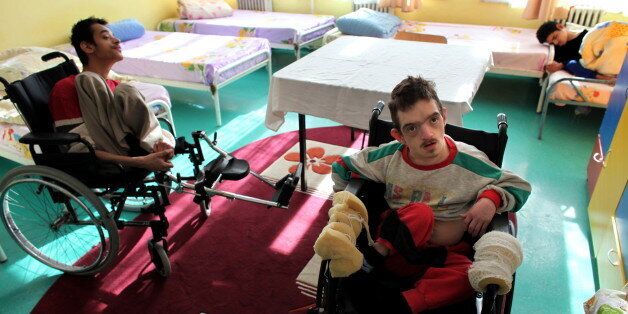
In 1990, the issue that catapulted Romania into the headlines in the West, after the rise and fall of Ceausescu, was the country's orphanages. Journalists and foreign health care workers were appalled to discover the condition of babies and children in the many state-run institutions in the country. During the Ceausescu era, abortions were difficult to obtain, and many families were simply too poor to handle another mouth to feed. The 700 orphanages scattered around the country were filled to bursting with 170,000 children.
Many of the children were healthy. Adoption agencies began to match children to eager parents abroad. In that first year, Romania sent 10,000 children abroad, and tens of thousands more before the Romanian government, citing corruption, imposed a moratorium in 2001.
But there were also many children that didn't fit the profile that most adoptive parents wanted. These were the "irrecuperables," the children with mental and physical disabilities who were warehoused in "hospitals." Romanian authorities, both during and immediately after the Ceausescu era, had deemed these children beyond recuperation.
In 1990, I tracked down one of these "hospitals" in the tiny village of Gradinari, about 20 kilometers outside of Bucharest. It was a sobering experience. "Since the weather was nice, the children were outside, in the backyard of a large institutional-looking building," I wrote at the time (the report is reproduced below). "There were over 100. The supervisor explained: 120 children and only 2 nurses. There were two long picnic tables crowded with children. A group of pens were set up underneath a tent. Several older children stood off to one side. One child, with only one leg, ambled around using his arm as a second leg. All the children were filthy, some with cuts, some only half-clothed. The children in the pens, their heads shaved, rolled around in their soiled diapers, some malnourished to the point of apparent starvation. The mixture of disabilities was staggering: Downs syndrome, autism, amputees, physical birth defects and so on."
On returning to Romania in 2013, I planned to go back to Gradinari to see what happened to the irrecuperables. It turned out, however, that I needed to apply for permission beforehand, and I ran out of time to get the necessary paperwork.
I did, however, have a chance to interview Bogdan Bobolea. He works with the Irish charity Comber which focuses on children and adults with disabilities in Giurgiu County, where Gradinari is located. A quarter century after the fall of Ceausescu, there are still many institutions and orphanages throughout Romania. Comber is working to close them down and build homes in the community for the residents. They've built two residential homes in Gradinari for 16 people. In the much larger Giurgiu city, they run two houses and four apartments, along with a day center that organizes activities.
Several recent news accounts have reported on the persistence of dreadful conditions in the remaining orphanages and institutions. The BBC made a secret film of its visit to several places in Giurgiu County, and this had prompted the government to institute its new permitting procedure.
Bobolea thought the BBC report one-sided. "We have improved, not much perhaps, but compared with what was in 1990, I think we've progressed a lot," he told me in Bucharest in May 2013. In terms of the institutions that haven't yet been closed down, "the buildings are better. The sanitary conditions are better. There are clothes. There are cleaning staff. The food is okay. What is missing is the specialized staff."
The institution that I visited in Gradinari, for instance, has been shut down. The children, now grown up, have been moved to other facilities. As Bobolea explained, children with disabilities have several options when they turn 18. "As soon as they reach 18, they have four options," he told me. "They can go to a big institution. They can go to an NGO if there are spots open in the residential facilities. They can go back to their families. Or they can go to a foster family."
The reality is a bit starker for most of these children, however. Foster families prefer children without disabilities. The original families are often reluctant to take on the challenge. And there are not many spots open in the residential facilities.
"The only available spot is when someone is taken home," Bobolea said. "But nobody is taken home. What we're doing now in Giurgiu is to put a couple beds in an office to house two persons. Or we're adding a fifth person to an apartment and that person will stay in the living room. It's better to use the available space if it's possible. But we cannot put more than five in an apartment."
The worst situation is when a child with disabilities has been living in a residential setting, turns 18, and there's no spot available in any of the houses or apartments for adults. They face the possibility of returning to one of the remaining large-scale institutions and losing the progress they'd made in the more supportive environment.
The EU has declared it a priority to close the orphanages and large-scale institutions. But it has not made sufficient funds available to build the houses and apartments that can serve as replacements.
I asked Bobolea how long it would take, if the EU funds were available, to close all the institutions.
"If the money is here on the table, it would take 10 years, maybe less," he replied. "We would have to build the houses. It takes one year of construction, and then you have to train the staff...maybe ten years. But without the money: indefinitely."
The Interview
You were explaining what's happened since I was here last and why it requires a permission to visit Gradinari.
I spoke with the deputy manager, and she said in order to have access you have to send an official request. But it's possible. It means that you can visit, but you need to sign a document that say that you won't use hidden camera, that you have a translator/interpreter.
Two or three years ago, a BBC crew, using a hidden camera, took some photos and actually recorded a video in Gradinari. It appeared in a movie broadcast on BBC. What they showed was true, but they didn't show the other side, the good things that have happened since 1990. They didn't speak with Comber or with the DGASPC [General Directorate for Social Assistance and Protection], because in that case it would have been a balanced documentary. We have improved, not much perhaps, but compared with what was in 1990, I think we've progressed a lot.
Why did they have to bring a hidden camera?
I don't know. You see now what's happening in the UK, with Bulgarians and Romanians there. Probably someone wanted a huge headline in the newspaper or on TV about what's happening here.
I'm interested how you became involved in this work.
Three or four years ago, when I was working in England, Comber had an advertisement in Romania for a project coordinator. One of my friends read that advert and sent it to me. I applied, and I had a phone interview with Fiona Dowling, who was the director at that time. Then we had a meeting in Dublin outside the airport. And then they hired me.
I came here at that time with another colleague who started work for Comber two or three years before I started. He showed me around. I visited all the institutions, and that was the start. I was involved at the beginning in the supervising of the building of a house in Izvoarele. We're still trying to open it. Then with this project over the summer, we had professionals, students, fresh graduates, or people with a lot of experience in fields like social work, social care, and psychology. They came here for four or five weeks and stayed in Giurgiu. We had many interpreters, high school students, who worked with the Romanian staff in our homes and apartments. This project ran for three years. This year we don't have any candidates. With trainings for the staff we opened a center with another NGO from Bucharest, and I also was involved in that. So basically, I was supervising the building of various structures, recruiting volunteers, and involved in this center.
Before you took the job, did you know very much about the situation here for children with disabilities?
For children, yes, because before that I worked only with children. So I knew about SERA from France. They closed two or three huge institutes in Bacau. There were children with physical disabilities and mental health associated with this. But regarding the adults, I am ashamed to say but I didn't know much about it.
Tell me a little bit about what happened since 1990 in terms of for the facility for children at Gradinari as part of the larger change.
What I know is that it was closed. It was refurbished, enlarged, and then it was closed. They were moved to Tantava. Some of them were sent to Bolintin. When I came here it was all shut down, so I don't know much about that. I saw the empty building, I was there several times, and I tried to imagine how it was at that time.
It was a big, big building. A lot of kids. And my understanding at the time was that there were one or two of those facilities in each county in Romania.
Maybe two or three. Still now there are many. If you have access to the national database, you can see there are at least two in each county, more than 50, 60, maybe 100. But, again, it's better to check again to have real figures.
Some have been shut down, but -
Most are still open. There was pressure from the EU to close the orphanages. And we invested a lot of money doing that. But regarding adults, even the EU Structural Funds (ESF) allocated money only to refurbish the old buildings or renovate them. We're building something nearby. But they didn't allocate money to build small residential care homes. So because it wasn't eligible for an NGO to apply to build two or three houses, Comber couldn't apply.
I was at a meeting in Bucharest two or three years ago. It was a huge table, and almost all the managers from religious charities were there, as well as someone from the financial ministry.
We asked,"What can you do?"
And this Romanian from the finance ministry, who also was the president of the body coordinating all the ESF funds in Romania, said, "The code is not written, and we cannot give you the money to refurbish or to build new small houses."
They knew that they couldn't get the money from the EU, and therefore they couldn't provide the money.
Yes, because it's not eligible. There are people putting pressure to change that, but I don't know what will happen. We'll see when they will launch a new line of finance.
Let's go back to the EU pressure to close the orphanages. They provided money...
To read the rest of the interview, click here.
